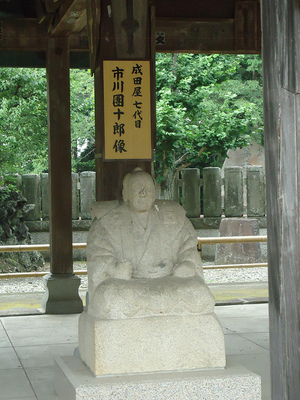Ichikawa Ebizo V

- Born: 1791
- Died: 1859/1/29
- Acting style: aragoto tachiyaku
- Japanese: 五代目市川海老蔵 (Godaime Ichikawa Ebizou)
Ichikawa Ebizô V was a kabuki actor who specialized in male hero (tachiyaku) roles, said to be the greatest of the 19th century. He was responsible for the establishment of the Kabuki Jûhachiban, a collection of the eighteen greatest plays in the repertoire.
Names
Like most kabuki actors, and many artists, of his time, Ebizô had a number of names. He was the fifth to be called Ichikawa Ebizô. His yagô was Naritaya. Other names he used on stage include Ichikawa Hakuen II, Ichikawa Danjûrô VII, and Ichikawa Shinnosuke I. In poetry circles, he often used the names Jukai (I), Sanshô, and Hakuen. Ebizô was also referred to in various circumstances as Ichikawa Jukai I, Matsumoto Kôshirô, Hatagaya Jûzô and Naritaya Shichizaemon II, though he did not formally use these names onstage.
Lineage
The son of Ichikawa Danjûrô V's daughter, he was formally adopted into the kabuki lineages by Ichikawa Danjûrô VI. Through these connections, he could trace his lineage back to the first Danjûrô.
Ebizô had a number of sons who became actors, under the names Ichikawa Danjûrô VIII, Ichikawa Danjûrô IX, Ichikawa Ebizô VII, Ichikawa Ebizô VIII, Ichikawa Komazô VI, Ichikawa Saruzô I, and Ichikawa Kôzô. He also had a great many disciples.
Life and Career
He was born in Edo in 1791, to the daughter of the famous Ichikawa Danjûrô V; his father owned a shibai jaya (a teashop inside the theatre), and is said to have been a musician and low-ranking samurai. He appeared onstage for the first time at the age of 3, as Ichikawa Shinnosuke, and took the name Ebizô V at the age of six.
The following year, he played the famous child roles of Emperor Antoku and Rokudai in Yoshitsune Senbon Zakura at the Nakamura-za, where he had made his premiere. His adopted father died in 1799, and Ebizô was officially designated to become the next Danjûrô, one of the greatest honors an actor could receive. After his grandfather died in 1806, Ebizô became Danjûrô VII the following year.
In the early 1810s, Danjûrô performed at the Ichimura-za in a number of new plays by the great playwright Tsuruya Nanboku IV, and played the titular role of Sukeroku in Sukeroku Yukari no Edo Zakura for the first time in 1811, alongside Iwai Hanshirô V and Matsumoto Kôshirô V. Upon its reopening in 1815, he moved to the Kawarazaki-za, along with Hanshirô, Kôshirô, and Seki Sanjûrô II. He performed primarily there, and at the Ichimura-za, for the next several decades, until 1840. Hanshirô, Kôshirô, and the famous onnagata Segawa Kikunojô V remained his chief partners onstage throughout this period.
Danjûrô retook the name Ebizô at a grand shûmei naming ceremony in 1832, passing on the name to his nine-year old son, who now became Ichikawa Danjûrô VIII. He played the role of Benkei in the 1840 premiere of Kanjinchô at the Kawarazaki-za. Two years later, he was arrested for violating the sumptuary regulations, and banished from Edo, his home destroyed.
Ebizô then performed in Kyoto and Osaka for the next eight years or so, alongside the likes of Ichikawa Kôdanji IV and Arashi Rikan III. After returning to Edo and to the Kawarazaki-za in 1850, Ebizô went on tour to Kamigata again in 1854, performing in Nagoya, Kyoto, and Osaka. That same year, upon Ebizô's arrival in Osaka, his son Danjûrô VIII committed suicide in the inn they were staying at.
Ebizô remained in the Kamigata area for several years, and then returned to Edo once more. At a performance at the Nakamura-za in the 12th month of 1858, he began to feel ill, and left the stage for several weeks. The following month, he was scheduled to perform as Soga no Iruka in Imoseyama Onna Teikin, but fell ill once more and died on the 29th.
References
- This article was written by User:LordAmeth and contributed to both the Samurai Archives Wiki and Wikipedia; the author gives permission for his work to be used in this way.
- Ichikawa Ebizô V at Kabuki21.com